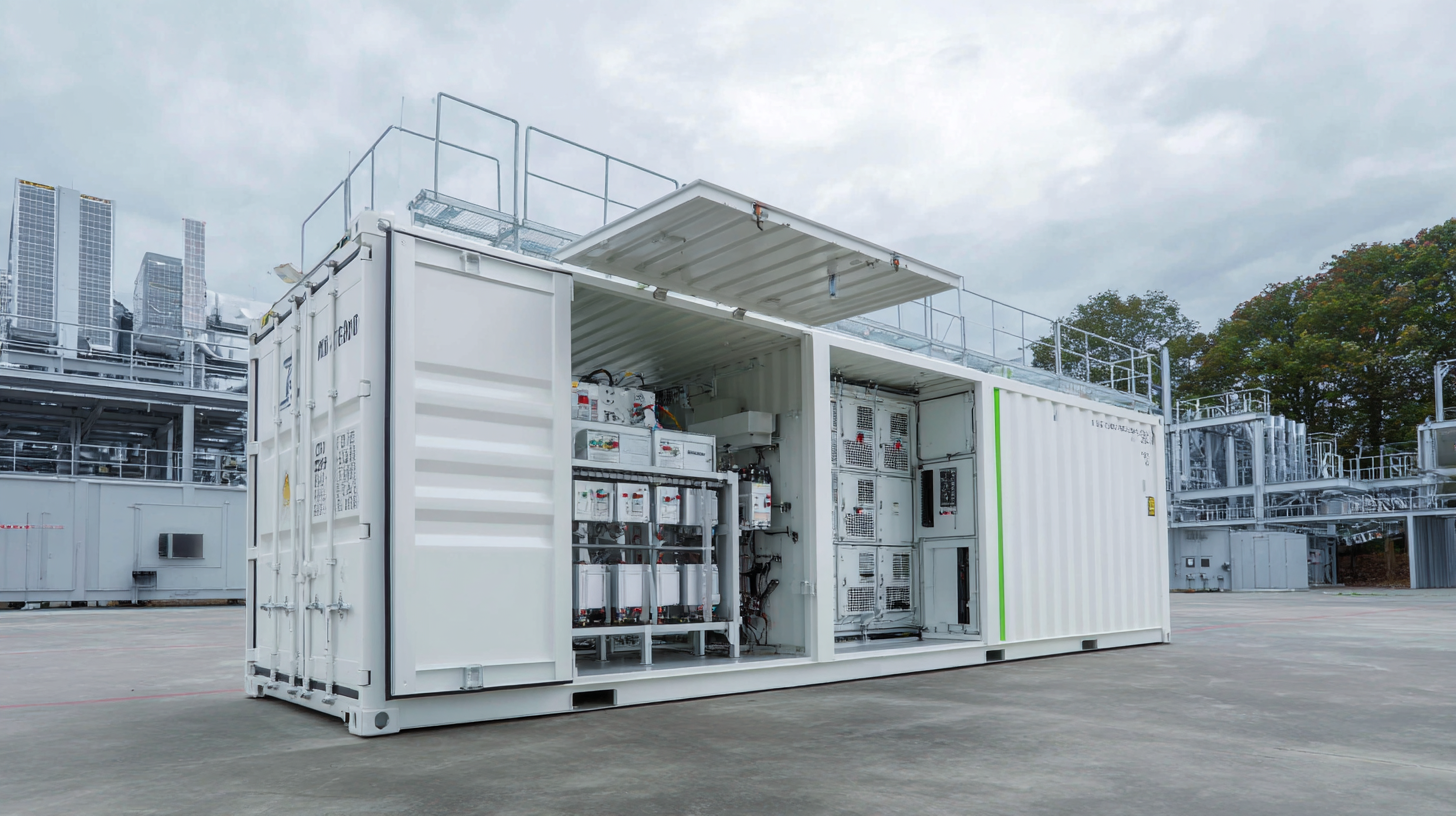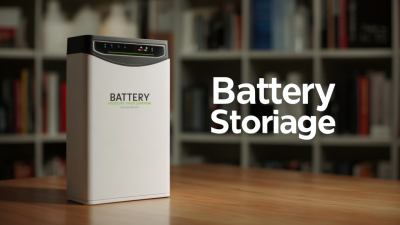Understanding the Future of Energy Storage Battery Technology Innovations and Applications
The rapid evolution of Energy Storage Battery technology is poised to revolutionize the energy sector as we transition towards a more sustainable future. According to the International Energy Agency (IEA), energy storage capacity is expected to exceed 1,700 gigawatt-hours (GWh) by 2040, driven by the demand for reliable and renewable energy sources. Innovations such as solid-state batteries and advanced lithium-ion systems are leading the charge, promising higher energy densities and improved safety.

Furthermore, a report from BloombergNEF highlights that global investment in energy storage technologies reached over $8 billion in 2020 alone, indicating a growing recognition of their critical role in balancing supply and demand. As we navigate the complexities of grid modernization and electric vehicle integration, understanding the advancements and applications of Energy Storage Battery technologies becomes imperative for stakeholders and consumers alike.
Emerging Trends in Energy Storage Battery Technologies
The landscape of energy storage battery technologies is evolving rapidly, driven by the growing demand for renewable energy and the need for efficient energy management solutions. Emerging trends include solid-state batteries, which promise higher energy densities and enhanced safety compared to traditional lithium-ion batteries. These innovations mitigate risks such as overheating and flammability, making them an attractive option for applications ranging from electric vehicles to grid storage.
Another significant development is the integration of artificial intelligence and machine learning in battery management systems. These technologies enable optimized charging cycles and real-time performance monitoring, enhancing the longevity and reliability of energy storage systems. Additionally, the rise of sustainable materials for battery production, such as sodium-ion and even bio-based components, reflects a shift towards more environmentally friendly energy storage solutions.
As these trends continue to unfold, they will undoubtedly shape the future of energy storage, making it smarter, safer, and more sustainable.
Key Materials Driving Innovations in Battery Performance
The advancements in energy storage battery technology are increasingly driven by a focus on key materials that enhance performance, efficiency, and sustainability. One notable innovation is the use of solid-state batteries, which substitute liquid electrolytes with solid materials. This shift not only increases energy density but also improves safety by mitigating risks associated with flammability. Materials such as lithium sulfide and ceramic electrolytes are at the forefront of this revolution, offering higher conductivity and longer life cycles, thus reshaping the landscape of battery performance.
Additionally, the exploration of alternative anode materials, like silicon and sodium, is gaining traction. Silicon, which has a theoretical capacity ten times greater than conventional graphite anodes, presents the opportunity for significantly more powerful batteries. On the other hand, sodium-ion batteries, utilizing more abundant materials, are emerging as a sustainable alternative to lithium-ion technology, making energy storage more accessible. Overall, these material innovations are pivotal in pushing the boundaries of battery technology, paving the way for greener, more efficient energy solutions.

Comparative Analysis of Different Battery Types for Various Applications
The future of energy storage battery technology is rapidly evolving, with various battery types gaining prominence across different applications. The microbattery market, which is set to grow from $519.78 million in 2024 to an impressive $2.16355 billion by 2032, highlights the increasing demand for smaller, efficient energy solutions, particularly in humanoid robotics and wearable devices. This growth is driven by technological advancements that enable these batteries to deliver better performance and longer life cycles, catering to a new wave of intelligent devices in diverse sectors.
Simultaneously, the industrial battery market is witnessing significant expansion as well, projected to rise from $22.51 billion in 2024 to $41.28 billion by 2032. This surge is largely attributed to the increasing reliance on energy storage systems within manufacturing and logistics, where high-capacity batteries are essential for operational efficiency. Additionally, the battery management system (BMS) market is expected to soar from $11.42 billion in 2024 to $46.94 billion by 2032, exhibiting a compound annual growth rate of 19.32%. These trends underline the critical role of innovative battery technologies in advancing both industrial and consumer applications, ensuring a sustainable future in energy utilization.
Understanding the Future of Energy Storage Battery Technology Innovations and Applications - Comparative Analysis of Different Battery Types for Various Applications
| Battery Type | Energy Density (Wh/kg) | Cycle Life (Cycles) | Cost ($/kWh) | Applications |
|---|---|---|---|---|
| Lithium-ion | 150 - 250 | 500 - 2000 | 150 - 300 | Consumer electronics, EVs |
| Lead-acid | 30 - 50 | 300 - 800 | 100 - 200 | Start-stop systems, backup power |
| Nickel Metal Hydride (NiMH) | 60 - 120 | 500 - 1000 | 200 - 400 | Hybrid vehicles, renewable energy storage |
| Solid State | 300 - 500 | 2000 - 5000 | 300 - 600 | EVs, portable devices |
| Flow Battery | 20 - 40 | 2000 - 10000 | 300 - 500 | Grid storage, renewable energy |
Integrating Renewable Energy Sources with Advanced Battery Systems
The integration of
renewable energy sources
with advanced battery systems is pivotal for the evolution of
sustainable energy solutions. As the reliance on
solar and
wind power increases, effective energy storage becomes essential to address the intermittency and variability of these renewable sources.
Advanced battery technologies, including
lithium-ion,
solid-state, and
flow batteries, are being developed to provide the necessary reliability and efficiency for storing excess energy generated during peak production times.
These innovations enable a more robust grid that can accommodate the influx of renewable energy while ensuring a steady supply for consumers. By harnessing and storing energy when it is abundant, advanced battery systems can discharge power during high-demand periods, thus reducing reliance on
fossil fuels and decreasing
greenhouse gas emissions. Moreover, the synergies created by integrating battery technology with smart grid systems allow for dynamic energy management, optimizing both production and consumption patterns to enhance overall system resilience and efficiency.
Future Challenges and Opportunities in Energy Storage Solutions
The future of energy storage solutions is poised to face both significant opportunities and challenges, particularly in the areas of solar and hydrogen technologies. By 2031, the solar panel market is projected to surge to $4.12 billion from $1.85 billion in 2024, reflecting a robust compound annual growth rate (CAGR) of 12.2% during this period. This growth is underpinned by the increasing global demand for clean energy and innovative battery technology, which is essential for maximizing the efficiency of solar energy generation and utilization.

Similarly, the hydrogen storage and distribution technology market is expected to expand from $4.1 billion in 2024 to $12.16 billion by 2033, indicating a CAGR of 13.2% from 2026 to 2033. This sector is critical as it addresses the need for sustainable energy solutions and plays an essential role in connecting clean energy production with its storage and application. As we navigate through this period of transformation in energy storage technologies, advancements in battery solutions will be integral to fostering both environmental sustainability and technological progress across various sectors, including electric vehicles and consumer electronics.
Related Posts
-

The Ultimate Guide to Maximizing Efficiency with Energy Storage Batteries: Key Trends and Innovations
-

How to Choose the Best Energy Storage Battery for Your Business Needs
-

Navigating the Setbacks in Energy Storage Battery Standards: A Global Perspective
-

Diving into Best Battery Storage Issues That Global Buyers Must Address
-

7 Compelling Reasons to Choose Best Energy Storage Lifep04 Battery for Your Business Needs
-

How to Choose Best Battery Storage Solutions According to Industry Manufacturing Standards
